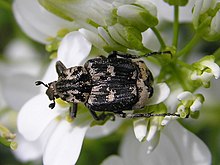
Anyphaenidae is a family of araneomorph spiders, sometimes called anyphaenid sac spiders. They are distinguished from the sac spiders of the family Clubionidae and other spiders by having the abdominal spiracle placed one third to one half of the way anterior to the spinnerets toward the epigastric furrow on the underside of the abdomen. In most spiders the spiracle is just anterior to the spinnerets. Like clubionids, anyphaenids have eight eyes arranged in two rows, conical anterior spinnerets and are wandering predators that build silken retreats, or sacs, usually on plant terminals, between leaves, under bark or under rocks. There are more than 600 species in over 50 genera worldwide.

Myrmarachne is a genus of ant-mimicking jumping spiders that was first described by W. S. MacLeay in 1839. They are commonly called ant-mimicking spiders, but they are not the only spiders that have this attribute. The name is a combination of Ancient Greek μύρμηξ, meaning "ant", and ἀράχνη, meaning "spider".

Flower chafers are a group of scarab beetles comprising the subfamily Cetoniinae. Many species are diurnal and visit flowers for pollen and nectar, or to browse on the petals. Some species also feed on fruit. The group is also called fruit and flower chafers, flower beetles and flower scarabs. There are around 4,000 species, many of them still undescribed.

Dorcus is a genus of beetles in the family Lucanidae. Of the 30-odd species, most occur in Asia and India; two are found in southern Europe, and two species are from North America. Previously, specimens with serriform teeth on the mandibles and sable pigment were called Serrognathus whereas specimens with but a singular or multiple bulky notches on the mandibles and lustrous sable pigmentation were called Dorcus.

Philoponella is a genus of uloborid spiders. Like all Uloboridae, these species have no venom.

Cheiracanthium, commonly called yellow sac spiders, is a genus of araneomorph spiders in the family Cheiracanthiidae, and was first described by Carl Ludwig Koch in 1839. They are usually pale in colour, and have an abdomen that can range from yellow to beige. Both sexes range in size from 5 to 10 millimetres. They are unique among common house spiders because their tarsi do not point either outward, like members of Tegenaria, or inward, like members of Araneus), making them easier to identify.

Melyridae are a family of beetles of the superfamily Cleroidea.

Plutodes is a genus of moths in the family Geometridae erected by Achille Guenée in 1857.

Ischiopsopha are beetles from the subfamily Cetoniinae, tribe Schizorhinini. The genus was created by Raffaello Gestro in 1874. The type species of the genus is Cetonia bifasciata Quoy & Gaimard, 1824. These cetoniids have only the tip of the scutellum visible. The genus is widespread throughout the whole Australian region.

Lomaptera are beetles from the subfamily Cetoniinae, tribe Schizorhinini. The genus was created by Gory & Percheron, in 1833. The type species of the genus is Cetonia papua Guérin-Méneville, 1830. These cetoniids have the tip of the scutellum invisible, which makes the difference with the genus Ischiopsopha.
Pseudocastalia is a genus of beetles in the family Buprestidae, containing the following species:

Melanargia is a genus of butterflies belonging to the family Nymphalidae and the subfamily Satyrinae.

Atractocerus is a genus of beetles in the family Lymexylidae. The most recent revision of the family treats several small or monotypic genera as synonyms of Atractocerus, though some authors continue to use the older generic names (e.g.).

Euryopis is a genus of comb-footed spiders that was first described by Anton Menge in 1868.

Agapanthiini is a tribe of longhorn beetles of the subfamily Lamiinae.

Dorcadion is a genus of longhorn beetles of the subfamily Lamiinae.

Callispa is a genus of tortoise beetles.

Danae is a genus of handsome fungus beetles in the family Endomychidae. There are more than 90 species in Danae, 1 found in North America, about 10 in Asia, and the remainder in Africa.

Platypria is a genus of hispine leaf-beetles. There are about 34 species found mostly in the Asian and African tropics. The larvae mine the leaves of plants and hosts include plants in the families Euphorbiaceae, Fabaceae, Myricaceae, Poaceae, Rhamnaceae, Roseaceae and Rubiaceae. The adults are 4 to 7 mm long and have spine like growths on the pronotum and elytra. There are also translucent patches on the elytra. The antennae have 9 segments and arise close to each other on the head.


















